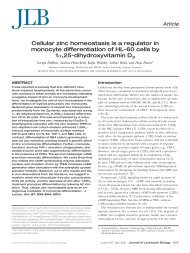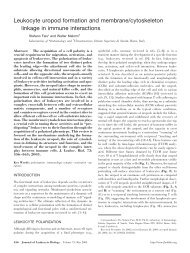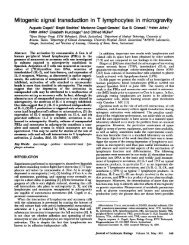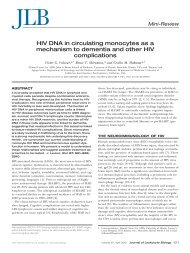Depletion of eosinophils in mice through the use - Journal of ...
Depletion of eosinophils in mice through the use - Journal of ...
Depletion of eosinophils in mice through the use - Journal of ...
You also want an ePaper? Increase the reach of your titles
YUMPU automatically turns print PDFs into web optimized ePapers that Google loves.
Fig. 1. Calcium mobilization <strong>of</strong> mCCR3 transfectants. (A) Calcium mobilization <strong>in</strong> Y3/mCCR3 cell l<strong>in</strong>e with various concentrations <strong>of</strong> eotax<strong>in</strong> from 1 µM to 0.5 nM<br />
as well as <strong>the</strong> Y3 parent l<strong>in</strong>e with 1 µM eotax<strong>in</strong>. (B) NIH3T3/mCCR3, Y3/mCCR3, and NIH3T3 parent l<strong>in</strong>e all stimulated with 1 µM eotax<strong>in</strong>.<br />
conjugated anti-mCCR3 mAb named 6SH2-59. Competitive<br />
<strong>in</strong>hibition showed that all 30 mAbs could block <strong>the</strong> sta<strong>in</strong><strong>in</strong>g <strong>of</strong><br />
6SH2-59. A representative example <strong>of</strong> <strong>the</strong>se experiments is<br />
shown <strong>in</strong> Figure 3. This observation suggested that all 30<br />
mAbs might share a common epitope.<br />
To more specifically def<strong>in</strong>e <strong>the</strong> epitope recognized by <strong>the</strong><br />
anti-CCR3 mAbs, peptides were generated correspond<strong>in</strong>g to<br />
<strong>the</strong> four extracellular portions <strong>of</strong> mCCR3, generally referred to<br />
as <strong>the</strong> am<strong>in</strong>o-term<strong>in</strong>al peptide, loop 1, loop 2, and loop 3 (Fig.<br />
4). An ELISA with <strong>the</strong>se four peptides showed that 25 <strong>of</strong> <strong>the</strong> 30<br />
mAbs bound only to <strong>the</strong> am<strong>in</strong>o-term<strong>in</strong>al peptide and that <strong>the</strong><br />
rema<strong>in</strong><strong>in</strong>g 5 did not b<strong>in</strong>d to any <strong>of</strong> <strong>the</strong> peptides. Given that all<br />
30 mAbs can cross-block <strong>the</strong> b<strong>in</strong>d<strong>in</strong>g to CCR3, and that 25 <strong>of</strong><br />
Fig. 2. Flow cytometry <strong>of</strong> mCCR3-transfected cell l<strong>in</strong>es<br />
us<strong>in</strong>g anti-mCCR3 mAb. (A) Flow cytometry <strong>of</strong> NIH3T3/<br />
mCCR3 (bold) and NIH3T3 parent l<strong>in</strong>e with FITC-6SH2-<br />
59. (B) Flow cytometry <strong>of</strong> Y3/mCCR3 (bold) and Y3<br />
parent l<strong>in</strong>e with FITC-6SH2-59.<br />
<strong>the</strong> 30 mAbs recognized <strong>the</strong> am<strong>in</strong>o-term<strong>in</strong>al peptide, it is clear<br />
that <strong>the</strong> epitope(s) recognized by those 25 mAbs is conta<strong>in</strong>ed<br />
with<strong>in</strong> <strong>the</strong> am<strong>in</strong>o-term<strong>in</strong>al peptide. The mAbs <strong>use</strong>d <strong>in</strong> subsequent<br />
studies, namely, 6SH2-59, 6SH2-88, and 6S2-19-4, all<br />
recognized <strong>the</strong> am<strong>in</strong>o-term<strong>in</strong>al peptide.<br />
Anti-mCCR3 mAbs specifically b<strong>in</strong>d<br />
to <strong>eos<strong>in</strong>ophils</strong><br />
The surface expression <strong>of</strong> CCR3 was analyzed on a variety <strong>of</strong><br />
mo<strong>use</strong> tissues and cell populations by immun<strong>of</strong>luorescent<br />
sta<strong>in</strong><strong>in</strong>g with FITC-conjugated 6SH2-59. Thymocytes, whole<br />
splenocytes, splenic T and B cells, dendritic cells, and bone<br />
Grimaldi et al. <strong>Depletion</strong> <strong>of</strong> mo<strong>use</strong> <strong>eos<strong>in</strong>ophils</strong> <strong>through</strong> <strong>the</strong> <strong>use</strong> <strong>of</strong> antibodies 849








